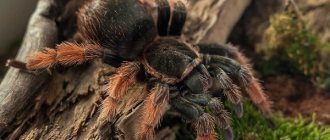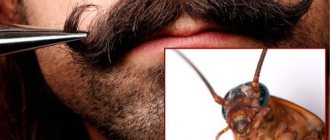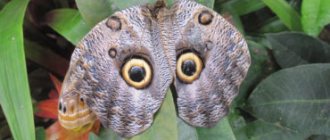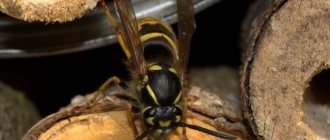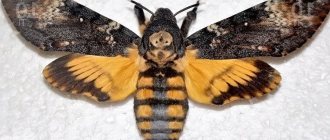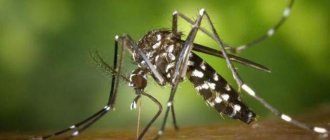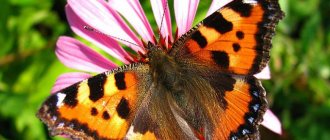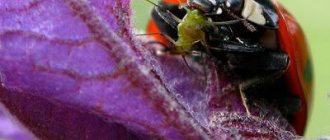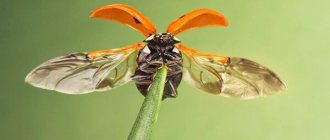August 3039630insectsladybugsbugs
Everyone knows such an insect as a ladybug. Each of us held this beetle in the palm of our hand and curiously counted the number of points on its back. Remember how in childhood we thought how many dots - how many years a ladybug is, how they sang rhymes, begging them to fly to the sky... The ladybug insect evokes joyful and enthusiastic memories from childhood. Below you will find a photo and description of the ladybug, you can learn a lot of new and unusual things about it.
What does a ladybug look like?
The ladybug looks quite small. The size of the ladybug reaches a length of 4 to 9 mm. The ladybug looks recognizable, because most often it is colored red and strewn with black dots. The ladybug has a convex, almost round body. The ladybug looks interesting, because there are so many small details in the structure of its body.
The ladybug insect has a head, pronotum, chest, abdomen, wings with elytra and paws. The ladybug has a small and short head, which is motionlessly connected to the pronotum. On the head of the insect there are eyes and movable antennae. The ladybug beetle flies using a pair of hind wings. The ladybug's forewings are rigid elytra that protect the main wings while it is on the ground. The ladybug flies well and makes up to 85 wing beats per second.
Everyone knows that the ladybug looks so bright to scare away predators. In addition to the variegated colors, the ladybug also secretes a yellow liquid with a sharp, specific odor. This liquid is poisonous and serves as protection against frogs, spiders and other potential enemies. The ladybug beetle secretes its poisonous liquid from the joints of its legs in case of danger. Also, when in danger, an insect can even pretend to be dead.
Of course, the red ladybug is not the only color option for this insect. There is a yellow ladybug, a black ladybug and even a white ladybug. What a ladybug looks like and what color it will be depends on the type of ladybug. At the same time, young individuals have the most saturated color; in older individuals, it fades over time.
Types of ladybugs, names and photos
The large family of ladybirds includes more than 4,000 species, divided into 7 subfamilies, which include approximately 360 genera.
The most interesting varieties of ladybugs:
Two-spot ladybird (Adalia bipunctata)
A beetle with a body length of up to 5 mm, dark red elytra and two large black spots. The prothorax lacks an anterior carina. The pronotum is black and has a yellow lateral border.
Seven-spotted ladybird (Coccinella septempunctata)
The most common ladybug in Europe. The size of a ladybug reaches 7-8 mm. The elytra are colored red; they have one small white spot (at the base) and three large black spots. The seventh spot of the ladybug is located on the pronotum (scutellum).
Twelve-spotted ladybug (Coleomegilla maculata)
The insect is 6 mm long and has pink or red elytra with 6 spots on each of them.
Thirteen-spotted ladybird (Hippodamia tredecimpunctata)
The dimensions of the elongated body of adult individuals range from 4.5 to 7 mm. The elytra of the ladybug are colored red-brown. There are 13 spots on them, some of which merge with each other.
Fourteen-spotted ladybird (Propylea quatuordecimpunctata)
It has yellow or black elytra with black or yellow dots.
Seventeen-spotted ladybug (Tytthaspis sedecimpunctata)
The insect's body is 2.5-3.5 mm long. Usually its color is bright yellow, sometimes it can be darker. These beetles live in Europe.
Asian ladybug (Harmonia axyridis)
The beetle has a body length of up to 7 mm. Within the species there are two subspecies. One of them has yellow wing covers with black spots, both large and small. The prothorax is white with a dark pattern. The second subspecies is characterized by black coloration of the elytra, on which red-orange spots are clearly visible. The prothorax is black with light yellow spots. This type of ladybug has 19 spots.
Ladybug (Hippodamia variegata)
Body size up to 5.5 mm. The pronotum is black and has two yellow spots. On the yellow-red elytra, 6 dark spots of various shapes and 1 large spot near the scutellum are clearly visible. The edges of the black pronotum are framed by a yellow border.
Ladybug (Anatis ocellata)
Quite a large insect with a body length of up to 10 mm. The color of the head and pronotum of this species of ladybug is black with small yellow spots. The elytra are yellow or red, each of them has black spots surrounded by lighter rims.
Alfalfa twenty-four-spot ladybird (Subcoccinella vigintiquatuorpunctata)
Pest of agricultural crops. A small bug with a body length of no more than 4 mm in an adult. The entire body of the ladybug is colored red. The elytra and pronotum are strewn with 24 small black spots.
Spotless ladybug (Cynegetis impunctata)
A rather rare species of ladybugs, the red or brown body of which is covered with small and thin fibers. The dimensions of the imago do not exceed 4.5 mm. There are no characteristic points on its elytra and pronotum.
Ladybug of the genus Sospita
has several types and color variations.
Ladybug Halyzia sedecimguttata
The insect has an orange wing cover with 16 white dots. Lives in Europe and the British Isles.
Ladybug Anatis labiculata
The insect is white or light gray with 15 black dots.
There is also a blue ladybug - this is Halmus chalybeus
Its elytra have a blue sheen, and its length reaches 3-4 mm. This insect lives in Australia.
Types of ladybugs
The types of ladybugs are very diverse. They all have different shapes, sizes, colors and number of points. There are even ladybugs without dots. More than four thousand species of ladybugs are known, which are grouped into 360 genera and are distributed in almost all parts of the world.
The most famous and common type of ladybug that we are most familiar with is the seven-spotted ladybug. It has the usual red color for us, and is named so because it has exactly 7 black dots. Below in the photo you can see different types of ladybugs.
Where does the ladybug live?
The ladybug lives almost everywhere except the Arctic and Antarctic. Ladybug lives on trees, bushes and grass in different parts of the world. Most often, the ladybug lives in the steppe zone, forests, mountains and gardens. In Russia, the ladybug lives almost throughout the entire territory, with the exception of the extreme northern regions. The ladybug also lives in Europe, Asia, Japan, China, India, Mongolia, Africa, Korea and America.
How does a ladybug live?
The ladybug lives, being active from early spring until late autumn. In winter, ladybugs hide under fallen leaves, tree bark or stones, where they remain until spring. But not all ladybugs live sedentary lives and remain to spend the winter where they spent the summer. Often, before the onset of cold weather, ladybugs migrate.
During wintering and migration periods, ladybugs, which usually lead a solitary lifestyle, gather together. Mass accumulations of this beetle are also typical during the mating season. In spring, the ladybug wakes up very early; for her, it is enough for the temperature to reach only +10 °C. Therefore, the ladybug can be one of the first to be seen after winter. Ladybugs live from 10 to 12 months and only occasionally up to 2 years. The lifespan of a ladybug depends on the availability of food.
Character and lifestyle of the ladybug
Ethnologists have observed how ladybugs gather in flocks in spring or autumn and go on long journeys.
Thus, the beetles are poisoned to spend the winter and return back in the spring. Almost like migratory birds.
They are forced to make unsafe long-distance flights in search of food. Mowed fields or meadows deprive cows of food, and they look for other places where there are still a lot of aphids.
Ladybugs fly so high above the ground that they may not be visible to the naked eye.
Sometimes, due to a strong gust of wind, the beetles leave the distance and interrupt their flight, and in some cases, flying over the sea, they die without ever seeing the shore.
Some cows gather in large flocks at the edges of the forest and prepare for the winter. Under a thick layer of leaves, under the bark of old stumps, they will shelter from frost until late spring.
While in wintering areas, ladybugs begin to show little activity and even appear on the soil when the average daily temperature rises to 5 degrees Celsius.
When the temperature reaches 10 degrees, some of the beetles from the forest-steppe fly to winter seedlings, to favorite perennial grasses and to abandoned virgin lands.
What do ladybugs eat?
It will probably be a great discovery for each of us that most ladybugs are predators. Because ladybugs eat aphids. A ladybug eats about a hundred aphids a day. In addition, ladybugs eat psyllids, scale insects, mites and scale insects. The ladybug larva is also predatory. Both the ladybug and its larva are very voracious.
The ladybug insect destroys various dangerous pests in huge quantities, which brings enormous benefits to agriculture. The seven-spotted ladybird was even specially brought to America to combat spider mites and aphids.
Of course, there are also herbivorous species of ladybugs. These ladybugs feed on plants and cause damage to agriculture. Herbivorous ladybugs are most common in the tropics of all continents and the subtropics of Southeast Asia.
In Russia there are 3 species of ladybugs that feed on plants. The 28-spotted ladybird causes damage to potatoes, tomatoes, cucumbers and other vegetable crops, the alfalfa ladybird damages sugar beets and alfalfa, and the pointless ladybird damages clover and sweet clover. All other types of ladybugs that live in Russia are predators.
Ladybug protection
Photo: Ladybug from the Red Book
Ladybug has long been listed in the Red Book of many countries, including Russia. Its complete disappearance threatens to disrupt the balance in nature and actively multiply pests, which will then have to be destroyed with chemicals, and this in turn will further destroy the balance - a vicious circle is obtained.
It is likely that in the near future people will completely abandon the use of chemicals and turn for help to ladybugs, which from time immemorial have lived next to people and helped them in the struggle for the harvest. It is not for nothing that since ancient times people have praised and worshiped this tiny bug.
Nowadays, the ladybug is successfully bred under artificial conditions. Then they are sent to the fields, but, according to many experts, it is enough just to create favorable conditions for these bugs and their population will recover on its own without human help and will remain at the level required by nature. It is necessary to maintain a balance, and for this, first of all, you should abandon the use of chemicals to treat crops against aphids, and also direct your efforts to reduce the overall level of environmental pollution.
Tags:
- Coleopterida
- Panarthropoda
- ladybugs
- Bilaterally symmetrical
- Ancient animals
- Coleoptera
- Animals of Asia
- Animals of the Antarctic Belt
- Animals of Germany
- Animals of Eurasia
- Animals of Europe
- Animals of the Red Book
- Animals of the Red Book of Russia
- Animals of the forest
- Animals of the forest-steppe
- Meadow animals
- Animals starting with the letter B
- Animals starting with the letter K
- Animals of the fields
- Animals of Russia
- Animals of the steppe
- Animals of the Subarctic Zone
- Animals of the Subtropical Zone of the Northern Hemisphere
- Animals of the Subtropical Zone of the Southern Hemisphere
- Animals of the Subequatorial Belt of the Northern Hemisphere
- Animals of the Subequatorial Belt of the Southern Hemisphere
- Animals of the Tropical Zone of the Northern Hemisphere
- Animals of the Tropical Zone of the Southern Hemisphere
- Animals of the Temperate Zone of the Northern Hemisphere
- Animals of the Temperate Zone of the Southern Hemisphere
- Animals of Switzerland
- Animals of the Equatorial Belt
- Animals of South America
- Winged insects
- Cucuyiformes
- Cucuyoides
- Shedding
- Insects of the Red Book
- Insects of the Red Book of Russia
- Insects with complete metamorphosis
- Unusual animals
- New-winged insects
- Protostomes
- Herbivorous beetles
- The most beautiful animals
- The smallest animals
- Tracheal breathing
- Arthropods
- Hexapods
- Eukaryotes
- Eumetazoans
Ladybug larva
The mating season for ladybugs occurs in mid-spring, when the insects have already gained strength after hibernation or migration. During the breeding season, the female secretes a special secret through which the male finds her. After which the female lays eggs on the plants. The ladybug chooses a place closer to aphid colonies so that the offspring are provided with food.
Ladybug eggs look like pointed, oval-shaped grains and can be yellow, orange or white. The female deposits them on the underside of the leaves or stems of the plant. One ladybug can lay up to 400 eggs, placing them in small piles. If the female feeds well, she can lay up to 1 thousand eggs.
After about a couple of weeks, variegated oval-shaped ladybug larvae with a bluish-gray tint appear from the laid eggs. The ladybug larva has thin bristles on its body and a peculiar pattern, which is formed by a combination of orange, yellow and white spots. After hatching, the ladybug larva eats the shell of its egg and the dead eggs. When the larva gets stronger, it begins to destroy aphid colonies. The voracious ladybug larvae eats up to 300 aphids per day.
The ladybug will remain in the larval stage for about 4-7 weeks. All this time, the ladybug larva is very mobile, because it is in constant search of food. The ladybug larva then develops into a pupa and attaches itself to the plant. As it develops, it begins to acquire all the characteristic features of a full-fledged insect. After about 10 days, a fully formed adult individual emerges from the cocoon.
What does a ladybug eat?
Photo: Miraculous ladybug
The ladybug is a real predator among insects. Thanks to the structure of its jaw and the functioning of its digestive tract, it is able to hunt other insects and then quickly digest them. There are varieties that choose plant food: pollen, mold, flowers and leaves.
The diet of predatory species includes mainly:
- aphids in huge quantities;
- spider mites;
- caterpillars;
- insect larvae;
- butterfly eggs;
- some do not even disdain the larvae of Colorado beetles.
Ladybugs eat a lot, they are always hungry, especially their larvae. Each individual can easily destroy more than a hundred aphid larvae per day. Having large eyes, insects mainly use only their acute sense of smell in search of food.
The bugs do not hunt their victims, but only slowly, leisurely move through the foliage in search of food, and when they find a colony of aphids or a clutch of eggs of pests, they linger for a long time in this place for a meal until they destroy it completely. That is why the ladybug is a welcome guest on any personal plot, agricultural fields with crops, and in the garden. They are even specially bred at special enterprises and then distributed over cultivated lands with the help of agricultural aviation. Unfortunately, some varieties of these bugs, mainly living in Asia, cause damage to crops.
Now you know what ladybugs eat. Let's see how to breed these beautiful insects.
Why is the ladybug called that?
It is still a mystery why the ladybug is called that. Perhaps it was called that because the ladybug insect is capable of secreting “milk” - a poisonous yellow liquid that scares away enemies. And she was probably nicknamed “God’s” for her harmless character and her help in preserving the harvest by destroying aphids.
The ladybug insect enjoys great sympathy and respect all over the world. In different countries, the ladybug is called differently. In Germany, Austria and Switzerland, the ladybug is called the "St. Mary's beetle." In England, the USA and Australia - “lady beetle”. In Latin American countries - “St. Anthony’s cow”. In the Czech Republic, Slovakia, Belarus and Ukraine it is called “sun”. In some countries, monuments are even erected in honor of the ladybug.
There are many beliefs and signs around this insect that foreshadow only good events. There are many legends involving the ladybug. The ladybug is considered a symbol of good luck; in ancient times, people worshiped and idolized this insect. The image of this beetle on clothing or various decorations were considered a talisman. In some cultures, it is forbidden to harm this insect so as not to attract trouble.
The ancient Slavs considered the ladybug to be the messenger of the Sun goddess. It is believed that you should not drive away a ladybug that has landed on you, so as not to frighten away your fortune. If she flies into the house, she brings peace and harmony to it. Even the weather was predicted with its help. This amazing and tiny insect with the simple name ladybug has such universal love.
If you liked this article and you like to read about animals, subscribe to site updates to be the first to receive the latest and most interesting articles about animals.
Don't forget to share with your friends!
